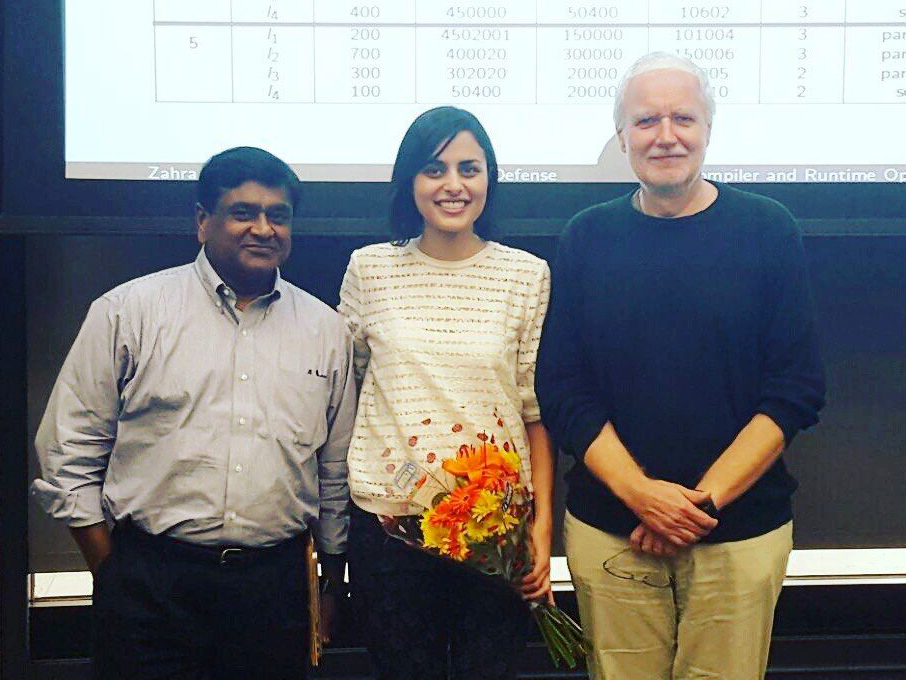LSU’s STE||AR Group Aligns High-Performance Computing Stars for SC20 Conference
The LSU STE||AR Group, which develops high-performance computing solutions and is housed in the Center for Computation & Technology (CCT), has been invited to host a panel about their work and the future of the field at the world’s premiere supercomputing conference, SC20. For the first time, the eleven-day conference will take place virtually, due to COVID-19, this November.

CCT Director Jagannathan “Ram” Ramanujam, LSU alumna Zahra Khatami, and Hartmut Kaiser, leader of the LSU STE||AR Group.
BATON ROUGE, September 1, 2020 — “We are excited and proud to have the trust of the community to organize a panel
about task-based algorithms and applications that will bring together experts within
the field of high-performance computing to present their ideas about the future of
computation,” Hartmut Kaiser, leader of the STE||AR Group, said. “This trust demonstrates that the community recognizes our work and our results
in the field.”
The LSU-led panel will be held on Wednesday, November 18 and address new challenges posed by exascale
(read, extremely fast; faster than the most powerful supercomputers used today) system
architectures that result in difficulties in using traditional distributed-memory
runtimes. Task-based programming models show promise in overcoming these challenges,
including the inherent load-balancing issues.
The LSU STE||AR Group is the lead developer of HPX, short for High Performance ParalleX, in the world.
The panel will be moderated by Patrick Diehl, LSU STE||AR Group researcher and an
expert on asynchronous many-task (parallel) systems. The invited panelists will explore
the advantages of task-based programming models on modern and future high-performance
computing systems from an industry, university, and national lab perspective and discuss
several concrete examples. Among the panelists are Laxmikant Kale, director of the
Parallel Programming Laboratory at the University of Illinois at Urbana-Champaign
and one of the lead developers of Charm++, which is based on C++-, both object-oriented
programming languages; Irina Demeshko, a design team leader at the Los Alamos National
Laboratory; Bryce Adelstein-Lelbach, one of the initial developers of the HPX parallel
runtime system and a core contributor to C++, now at NVIDIA; Keno Fischer, a key developer
of the Julia programming language and co-founder of Julia Computing; and Alice Koniges,
a computer scientist at the University of Hawaii and associate editor of the International
Journal of High Performance Computing Applications.
Joining them in November will be LSU computer engineering alumna Zahra Khatami who
designs and develops distributed database systems for Oracle. After graduating from
LSU with her Ph.D. in 2017, Khatami has been collaborating with the STE||AR Group
on several HPX projects, one of which leveraged artificial intelligence to handle
runtime parameters more efficiently. The LSU STE||AR Group is the lead developer of
HPX, short for High Performance ParalleX, in the world.
“When I joined Oracle, I realized scalability plays an important role when dealing
with very large numbers of tasks,” Khatami said. “I then appreciated the power of
the asynchronous many-task-based runtimes I’d learned about during my Ph.D. Attending
as a panelist this November will give me a chance to interact with experts in this
field in both academia and industry and discover more about how we can resolve practical
scalability and compatibility problems.”
LSU’s senior scientist Hartmut Kaiser, finally, is probably best known through his
involvement in open-source software projects and as the author of several C++ libraries
used by thousands of developers worldwide. He is also a voting member of the ISO C++
standards committee.
For more details on the panel, click here.
Elsa Hahne
LSU Office of Research & Economic Development
ehahne@lsu.edu